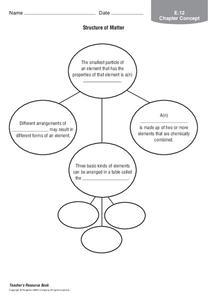Curated OER
Practice Final
A full-fledged practice final prepares pupils for their general chemistry final exam. If they complete these 57 multiple-choice questions correctly, they will be well-prepared. Note: even though the questions are multiple-choice, there...
Curated OER
Protons, Neutrons, and Electrons
Using the periodic table of elements, young chemists fill in a chart of isotopes to show the atomic number, mass, charge, number of protons, number of neutrons, and number of electrons. The chart is followed by 11 questions that...
Curated OER
Atomic Structure
A flashy PowerPoint includes clear summaries of atomic structure and electronic configuration. Dot and cross diagrams will help viewers learn how to draw an atom. As a result, learners should be more clear how electronic configuration...
Curated OER
Atomic Structure in the Chemistry Classroom
Students are introduced to many of the scientists who contributed to the creation of the model of the atom. The changes to and evolution of the model over time is also covered. At the end of the lesson, Students differentiate between...
Curated OER
The Periodic Table
A huge collection of slides introduces chemistry learners to the periodic table of elements, electron configuration, and electronegativity. It opens with the history of today's periodic table, and then details the arrangement. After...
Curated OER
Conductors and Insulators
Fifth graders explore conductors and insulators. In this science lesson, 5th graders act as electrons moving through a wire. Students break into groups representing conductors and insulators and explore how they work with electrons.
Curated OER
Modern Physics, Old QT
In this physics worksheet, students develop an understanding of the atomic model and how atoms relate to one another through answering the seven questions.
Curated OER
Properties of Matter
Ninth graders explore the molecular structure of matter and how it can affect the physical characteristics of a specific material. They demonstrate that isotopes of an element have different masses. Students demonstrate that the rates of...
Curated OER
Ionic and Covalent Bonds
Ionic and covalent bonds are the focus of this chemistry activity, which provides learners with eighteen key terms to use in a fill-in-the-blank activity. Additionally, students are prompted to write the number of atoms in four given...
Curated OER
The Periodic Table
In this periodic table worksheet, students review the elements and how they are organized in the periodic table. This worksheet has 10 fill in the blank, 6 multiple choice, and 5 short answer questions.
Curated OER
Alternative Energy Resources
In this alternative energy resources instructional activity, learners identify the ore that is commonly used in nuclear power plants and how it is processed. Then they determine the reaction that occurs when uranium atoms are split....
Curated OER
Structure of Matter
In this matter worksheet, students review the structure of matter including elements, atoms, and the periodic table. This worksheet is a graphic organizer.
Curated OER
Atoms
In this atoms learning exercise, students use their knowledge of the periodic table and of atomic structure to complete the table on atoms. They identify the notation for each and then the atomic number, mass number, the number of...
Curated OER
Chemistry
In this chemistry worksheet, students describe an atom, its parts, the charges of these parts, and atoms life functions. Then they explain what the octet rule states for the placements of electrons around the nucleus of an atom. Students...
Curated OER
Moles Worksheet
In this chemistry worksheet, students identify and write how many significant figures they would use for each problem. Then they round the answers to the appropriate number of significant figures. Finally, students calculate the mass of...
Curated OER
Atomic Structure
In this atomic structure worksheet, students use the periodic table to complete a chart for 11 elements/ions in terms of atomic number, number of protons, neutrons and electrons.
Curated OER
Periodic Table
Explanations of shell structure in an atom and the decisions that affect periodic table organization are discussed here. Students view well organized charts to list and compare elements that are placed in different sections of the...
Kenan Fellows
Isotopic Pennies
Many people confuse atomic mass and atomic numbers. The sixth of seven lessons in a unit requires scholars to find the weight of different groups of pennies. Then, they must solve how many of each type of penny exists in a closed system...
Science Geek
Intermolecular Forces of Attraction
Chemists love London (dispersion forces)! Presentation begins with an explanation of intermolecular forces including hydrogen bonding, dipole-dipole attraction, and London dispersion forces. It also covers polarity and the relative...
Biology Junction
Macromolecules
In chemistry, organic means something contains a carbon base. A helpful presentation starts by defining macromolecules as large organic carbon molecules. Scholars answer questions about each topic on the associated worksheet. It covers...
Royal Society of Chemistry
Electronegativity Values
Finally, an electronegativity resource your class will be strangely drawn to! Skilled scientists manipulate interactive puzzles to gain an understanding of common electronegativity values. The great thing? You can conduct the lesson...
Royal Society of Chemistry
Shapes of Molecules—Distortion from the Pure Geometry
Ready to introduce the realities of molecular geometry to chemistry pupils? Use a logic-based interactive! Perfect as individual practice, the puzzles explore the bond angles and repulsions present in three common molecular shapes.
Curated OER
Combination of Atoms
In this atoms worksheet, students review protons, neutrons, electrons, molecules, compounds, and ions. This worksheet has 10 fill in the blank and 3 problems to solve.
Curated OER
Where's the Period in the Periodic Tables?
Students investigate the Periodic Table of Elements. The teacher is provided with the necessary background information to complete the lesson. Students practice matching the element symbol to its place on the chart.

























